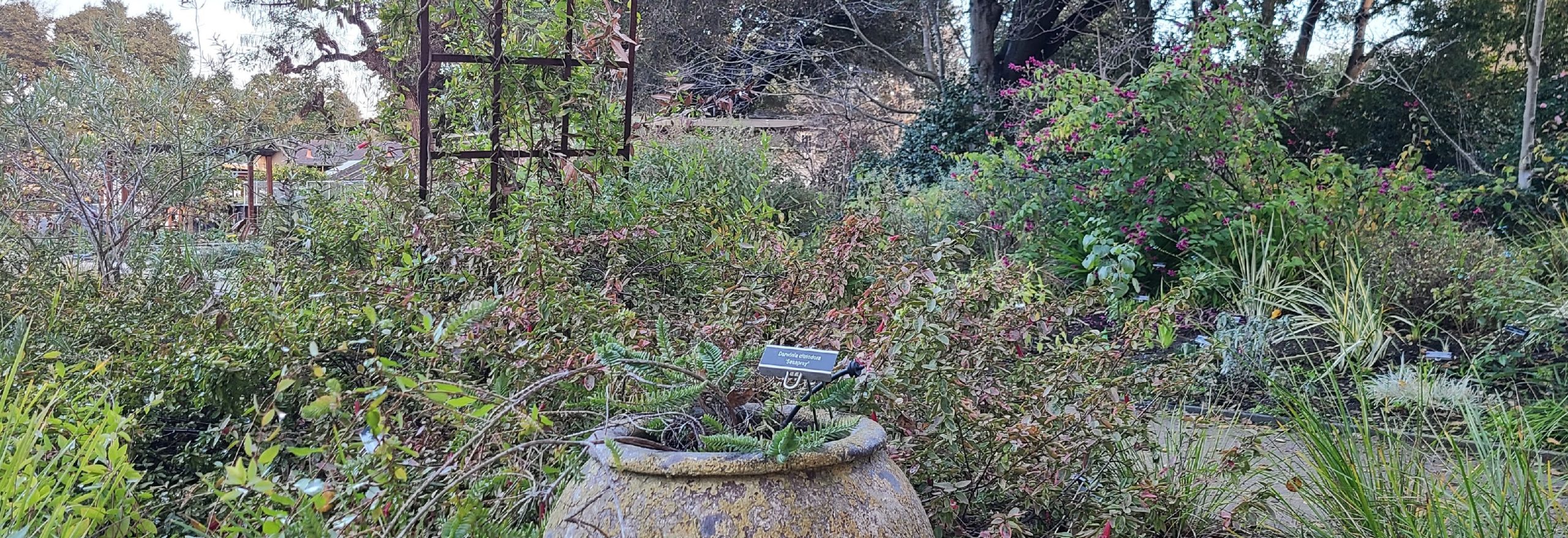The Mediterranean Beds consist of four stone-bordered beds, designed around the ancient idea of a quadripartite paradise garden. Four paths separate the quadrant beds leading to the garden’s center. Each quadrant represents one of the regions outside California with a mediterranean climate; please explore each quadrant’s specimens below.

Multiple regions, similar growing conditions
How non-native plants can flourish thousands of miles away from their origin and contribute to regional biodiversity
Asphodeline lutea
Bupleurum fruticosum
Buxus balearica
Cyclamen graecum & C. persicum
Drimia maritima
Iris pallida ‘Variegata’
Iris unguicularis
Helleborus argutifolius & H. x sternii
Myrtus communis ‘Compacta Variegata’
Olea europaea ‘Montra’
Scilla peruviana
Teucrium flavum
Thymus thracicus
Trachelium caeruleum
Virburnum tinus ‘Spring Bouquet’
Banksia blechnifolia
Boronia crenulata ‘Shark Bay’
Chrysocephalum ‘Silver & Gold’
Correa ‘Wyn’s Wonder’
Darwinia citriodora ‘Seaspray’
Dianella revoluta ‘Little Rev’
Gastrolobium celsianum
Grevillea olivacea
Hardenbergia violacea ‘Meema’
Kennedia prostrata
Orthrosanthos multiflorus
Sollya heterophylla ‘Monterey Sapphire’
Western Cape, South Africa Bed
Amaryllis belladonna
Anisodontea ‘Strybing Beauty’
Elegia tectorum
Euryops virgineus
Helichrysum argyrophyllum
Kumara plicatilis
Leucandendrons: ‘Ebony’, ‘Chief’, ‘Little Bit’, ‘Jubilee Crown’, & ‘Winter Red’
Salvia chaemelaeagnea, S. lanceolata, & S. muirii
Bulbs (Babiana, Bulbinella, Freesia, Ixia, Moraea, Sparaxis)
Aldama revoluta
Alstroemeria ligtu & A. hookeri
Cistanthe grandiflora
Crinodendron patagua
Fragaria chiloensis (also native to CA)
Lobelia excelsa
Pasithea caerulea
Puya coerulea, Puya venusta, & Puya chilensis
Sisyrinchium striatum ‘Aunt May’
History
Gamble’s Mediterranean Beds were first installed in the early 2000’s. Ten years after, the beds had fallen into disrepair. Landscape Designer and Gamble volunteer Cheryl Renshaw writes, “The original plant design was hard to see. Euphorbia seedlings overran the beds, the pebble mulch kept migrating into the froggy fountain, and few of the other original plants remained.
Thanks to a generous anonymous donation, the beds were refurbished from the winter of 2012 till the spring of 2013. The current quadrilateral layout was designed by Cheryl Renshaw. The stone walls were raised on the outer bed borders and a lot of sand and gravel was added to the soil to improve drainage. New dripline irrigation was installed, new plantings were added, and the soil was covered with new gravel mulch.
In 2021, new informational signage was installed in the Mediterranean bed signage thanks to a 2019 grant from the Woodside-Atherton Garden Club. The club is nonprofit organization dedicated “to stimulating and sharing knowledge about conservation, horticulture, floral design and photography.”
The beds and updated signage help visitors see the growing conditions can be shared across multiple regions and that non-native plants can flourish thousands of miles away from its origin. The signs were redesigned by Gamble Garden Assistant Cheryl Renshaw and former Gamble intern Mia Groff.





